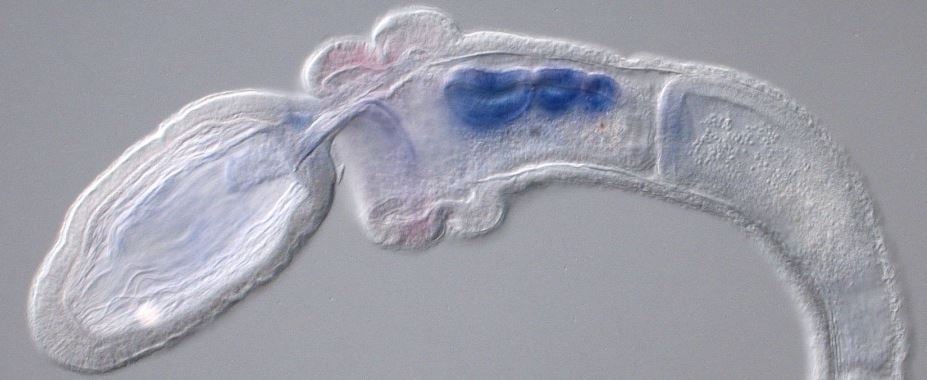Acorn worms and humans are distant cousins – these slimy invertebrates are closer to us genetically than many other animals, says a team of scientists from Japan, UK, USA, Germany, Taiwan and Canada.
Lead author, Dr. Oleg Simakov, from the Okinawa Institute of Science and Technology (OIST) Graduate University in Japan and colleagues wrote in the academic journal Nature that they sequenced the genomes of two species of acorn worms, and found that 8,600 families of genes are shared across deuterostomes.
Deuterostomes belong to a large animal grouping including several types of organisms, ranging from acorn worms (enteropneust) to star fishes, from frogs to dogs, to humans.
 An acorn worm – our distant cousin. (Image: www.oist.jp)
An acorn worm – our distant cousin. (Image: www.oist.jp)
This means that about 70% of human genes can be traced back to the original deuterostome.
Humans and acorn worms share a 500 million year old ancestor
By comparing the acorn worms’ genes to other animals, the scientists assumed that these genes were present in the common ancestor of all deuterostomes, an animal that became extinct about 500 million years ago.
This study demonstrated that the pharyngeal gene cluster is unique to the deuterostomes and might be associated with the development of the pharynx, the membrane-lined cavity behind the nose and mouth, connecting them to the esophagus in humans.
Approximately 550 million years ago, there was a sudden burst of new animal types in the world in an event known as the Cambrian explosion.
This evolutionary radiation revealed many new animal body plans, and altered life on Earth forever, as complex animals with sophisticated digestive systems and behavioural features emerged.
We may unveil the features of our common ancestor
After sequencing the genomes of several contemporary animals of the deuterostome group, today we are able to go back in time to reveal the features of the long-lost ancestor of this diverse group of animals.
Acorn worms live on the ocean floor and feed by filtering sea water through slits between their mouth and esophagus. These slits are related to fish gills, and represent a critical milestone in evolution, not shared with animals like earthworms or flies.
Given that acorn worms occupy such a critical evolutionary position in relation to humans, the scientists sequenced two distantly related acorn worm species: Saccoglossus kowalevskii collected in the Atlantic Ocean, and Ptychodera flava in Hawaii.
“Their genomes are necessary to fill the gap in our understanding of the genes shared by the common ancestor of all deuterostomes.”
The researchers were also interesting in identifying the ancient gene families that already existed in the deuterostome ancestor.
Deuterostomes share 8,600 families of genes
The scientists compared the two acorn worms’ genomes with those of 32 different animal species and found that 8,600 families of genes are homologous, i.e. evolutionary related, across all deuterostomes. The researchers are therefore fairly confident that those families of genes were present in the genome of the deuterostome ancestor.
Examples of homology are whales’ flippers, cats’ paws, birds’ wings and human arms, because they all derive from the limbs of a common ancestor.
As with the structures of parts of the body, genes homology is defined in terms of shared ancestry. These 8,600 homologous genes correspond to 14,000 or more genes, when taking into account gene duplications and other processes, or about 70% of the current human genome.
The researchers also identified gene clusters that are close together in human genomes, acorn worm genomes, and those of other vertebrates (animals possessing a backbone or spinal column).
Genes may function as a unit
The ancient proximity of these clusters of genes, preserved over 500 million years, suggests that the genes could function as a unit.
Of particular interest is one gene cluster related to the development of the pharynx in acorn worms and vertebrates. All deuterostomes have it, but non-deuterostome animals such as flatworms, earthworms, octopuses and insects don’t.
In acorn worms and other animals, the pharynx serves to filter food and guide it to the digestive system. In humans, the cluster is active in the formation of the pharynx and thyroid gland.
Scientists believe there is a connection between the function of the thyroid gland today and the filter feeding mechanism of acorn worms.
OIST wrote in a press release:
“This pharyngeal gene cluster contains six genes ordered in a common pattern in all deuterostomes and includes the genes for four proteins that are critical transcriptional regulators that control activation of numerous other genes.”
Genes ordered identically and located next to one another in the chromosomal DNA are linked and transferred together from generation to generation. Interestingly, deuterostomes do not only share the DNA that codes these transcription factor genes, but also a number of DNA pieces that are used as binding sites for the transcription factors are conserved in these animals.
Dr. Simakov said:
“Our analysis of the acorn worm genomes provides a glimpse into our Cambrian ancestors’ complexity and supplies support for the ancient link between the pharyngeal development and the filter feeding life style that ultimately contributed to our evolution.”
Citation: “Hemichordate genomes and deuterostome origins,” Oleg Simakov, Takeshi Kawashima, Ferdinand Marlétaz, Jerry Jenkins, Ryo Koyanagi, Therese Mitros, Kanako Hisata, Jessen Bredeson, Eiichi Shoguchi, Fuki Gyoja, Jia-Xing Yue, Yi-Chih Chen, Robert M. Freeman, Akane Sasaki, Tomoe Hikosaka-Katayama, Atsuko Sato, Manabu Fujie, Kenneth W. Baughman, Judith Levine, Paul Gonzalez, Christopher Cameron, Jens H. Fritzenwanker, Ariel M. Pani, Hiroki Goto, Miyuki Kanda et al. Nature. 18 November, 2015. DOI: 10.1038/nature16150.
